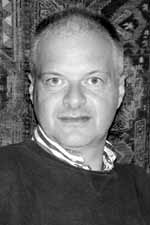Van
Pelt was an expert witness for the defence in the
2000 Libel Action DJC Irving v Penguin Books Ltd
and Deborah
Lipstadt
Alphabetical
site index (text) | | [Images added by
this website] 
London, Friday, November 29, 2002 In a special
examination of detailed writing between the lines
of conventional Holocaust literature, David
Cesarani considers an analysis of trial
evidence  The
Case for Auschwitz: Evidence from the Irving
Trial by Robert Jan van Pelt. Indiana University
Press. 570 pages. $ 45 The
Case for Auschwitz: Evidence from the Irving
Trial by Robert Jan van Pelt. Indiana University
Press. 570 pages. $ 45
 THE
LAST time I wrote a JC review of a book about
Auschwitz
by Robert Jan van Pelt (right), it
attracted the attention of David Irving
[January
17, 1997] and I
found myself dragged into the malign world of
Holocaust-denial. This time, I suspect Mr Irving
will not bother. He's heard it all
before. THE
LAST time I wrote a JC review of a book about
Auschwitz
by Robert Jan van Pelt (right), it
attracted the attention of David Irving
[January
17, 1997] and I
found myself dragged into the malign world of
Holocaust-denial. This time, I suspect Mr Irving
will not bother. He's heard it all
before.
This book joins several published by expert
witnesses in the Irving v Lipstadt libel trial.
Although it weighs in at over 500 pages, Van Pelt's
tome is actually 200 pages shorter than the report
on which it is based. Van Pelt says he decided to
publish this version to meet requests from the
media and the public for the arguments against
those who deny the existence of homicidal gas
chambers at Auschwitz-Birkenau or the part they
played in the Nazis' systematic effort to
annihilate Europe's Jews. However, it has to be
asked whether a volume of such forbidding
dimensions will serve such a laudable purpose.
Van Pelt devotes so much space and detail to the
"negationist" case that the reader is fatigued
when he eventually gets to evidence of the gas
chambers.  This
is a pity, because the core of the book offers an
invaluable review of the information available
between 1942 and 1947 about the genocide at
Auschwitz-Birkenau. Van Pelt operates within this
time-frame in order to refute two elements of
denial propaganda: first, that the gas chambers
were a contemporary invention by British political
warfare experts and, second, that they were a
post-war fabrication involving false confessions by
captured Nazis. This
is a pity, because the core of the book offers an
invaluable review of the information available
between 1942 and 1947 about the genocide at
Auschwitz-Birkenau. Van Pelt operates within this
time-frame in order to refute two elements of
denial propaganda: first, that the gas chambers
were a contemporary invention by British political
warfare experts and, second, that they were a
post-war fabrication involving false confessions by
captured Nazis.
He shows how the Polish underground and escapees
from Auschwitz-Birkenau alerted the world to the
camp while the war raged. After Auschwitz was
overrun by the Red Army, Soviet and Polish
commissions of investigation examined survivors,
scrutinised captured documents and conducted
forensic investigations to establish the infamous
details. War-crimes trials merely added
confirmation by the perpetrators. Despite some
overlong quotations, Van Pelt sustains the pace of
this narrative, guiding the reader through the
evidentiary maze. Unfortunately, the chapter on "unintentional
evidence" -- the plans, photographs, and remnants
of the gas chambers -- is congested and convoluted.
Even though we are reminded that horrendous human
suffering lies behind the calculations about the
concentration of hydrogen cyanide needed to kill
lice or humans and the expected residue to be found
in the ruins, the effect of the data is mind
numbing. Only a fanatical denier or fanatical advocate
for the truth would want this information in this
form. It would have been more effective to have the
data in appendices -- or on a website.  The
detail almost overwhelms some fascinating insights
into the conduct of the case and the main
personalities. Van Pelt discovered Irving was never
wholly at ease with the "negationist" case. But the
French denier Robert
Faurisson (right) goaded him on,
comparing him to a "half-pregnant woman." The
detail almost overwhelms some fascinating insights
into the conduct of the case and the main
personalities. Van Pelt discovered Irving was never
wholly at ease with the "negationist" case. But the
French denier Robert
Faurisson (right) goaded him on,
comparing him to a "half-pregnant woman."
Van Pelt also reveals that, on a visit to
Auschwitz, Richard Rampton QC, the leading
defence barrister, told him "that if he were to
stay much longer he would be too enraged to conduct
the case." During the victory dinner on April 11
2000, Rampton's composure broke. He sobbed to Van
Pelt: 'the judgment doesn't bring back the dead,"
and confessed: "I am deeply ashamed that for all
those years I thought I knew, and I did not." Now,
thanks to Van Pelt, everyone who wants to know,
can. David Cesarani is professor of
modern Jewish history at Southampton University.
He recently edited, with Paul Levine,
"Bystanders to the Holocaust: A Re-evaluation"
(Frank Cass). Website
Note: We have now posted the entire 150 page
British
Army Intelligence
Dossier
on
Aumeier, erstwhile commandant of Auschwitz, in text
and pdf form. This was the file which (like the
Hoess interrogations) Pelt never bothered to read
when writing his famous history of
Auschwitz.
Related files on this website:  Index
to Van Pelt
Index
to Van Pelt Investigation
on Auschwitz statistics in reputable journal
Osteurropa quietly agrees that the Kremas were
not gas-chambers, actual deathtoll exaggerated
by a factor of ten
Investigation
on Auschwitz statistics in reputable journal
Osteurropa quietly agrees that the Kremas were
not gas-chambers, actual deathtoll exaggerated
by a factor of ten Van
Pelt testifies on oath Jan 25, 2000 that he has
no plans to publish his Report as a
book
Van
Pelt testifies on oath Jan 25, 2000 that he has
no plans to publish his Report as a
book Indiana
University Press announcement of Van Pelt's new
book
Indiana
University Press announcement of Van Pelt's new
book First section of Van
Pelt's book, posted for research purposes
only
First section of Van
Pelt's book, posted for research purposes
only "Sam
Crowell" reviews the book for this
website
"Sam
Crowell" reviews the book for this
website The
Jerusalem Post review: Murdering
History
The
Jerusalem Post review: Murdering
History Matthew
Herrington Reviews the book for FindLaw
Matthew
Herrington Reviews the book for FindLaw Brian
Renk's critique of van Pelt's arguments on the
"holes"
Brian
Renk's critique of van Pelt's arguments on the
"holes" Cesarani:
Britain was 'wary' of Nazi [sic. Jewish]
refugees
Cesarani:
Britain was 'wary' of Nazi [sic. Jewish]
refugees
|
|